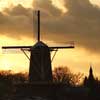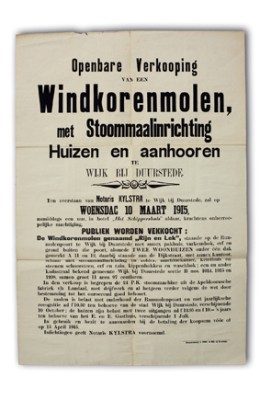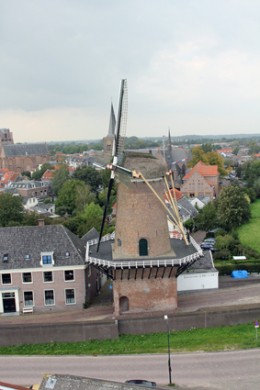The History
In 1659, Anthony van Eyndhoven submitted a request to build a windmill on one of the town gates: the Leuterpoort. That particular town gate – a tower built as living quarters – was constructed in the 14th century. Times were tough financially. By building a bark mill, Anthony wanted to contribute to Wijk bij Duurstede’s employment opportunities. The product of a bark mill, tanbark, is finely ground bark from oak trees, used for tanning leather. Wheat was not to be milled on Rijn en Lek. That was the privilege of the Han Loyentoren, Ruisdael’s windmill. There was a lot of protest about the Rijn en Lek Windmill from surrounding inhabitants, who were afraid the smell would be a nuisance. But permission was given to first demolish a part of the gate and build a mill on top. By buying the house next to the mill, Van Eyndhoven solved the problem of unhappy neighbours. Over the following centuries, this house became the miller’s living quarters. After Anthony van Eyndhoven, the windmill had several owners. These were not always the millers themselves, but also owners for whom the mill served as an investment. Until the Napoleonic period, Ruisdael’s mill was the only one allowed to mill wheat. For the last years of its existence it served as an oil mill, while the Buitenmolen (Outside Mill), which used to be across from the Albert Heijn, was the community’s wheat mill. Around 1820, Ruisdael’s mill and the Buitenmolen were torn down. From that moment onward, the Rijn en Lek Windmill was also used for wheat. In 1824, Jocobus Johannes de Heus bought the Rijn en Lek Windmill, which would remain in the family for five generations. Due to the rise of mechanisation and the family's bad management, business declined. In 1914, Pieter de Heus’s business went bankrupt and he put the windmill up for sale. For 11,000 guilders, the windmill became the property of a cooperative. In 1924, the windmill was again put up for sale. Three farmers, the gentlemen Van Dijk, Lokhorst and Schoenmaker, bought Rijn and Lek. Miller Gerrit Jan Roodvoets became the manager. Business went well, but more and more of the activity was carried out by machinery. The windmill was no longer necessary for milling. The danger of the building being torn down was a real risk. To prevent losing the windmill, without which our current river landscape would be unimaginable, a committee of concerned citizens was formed under the leadership of Frits Thieme. They managed to raise six thousand guilders, which for that time was a large sum of money.
Contact was established with The Dutch Mill Society (De Vereniging de Hollandsche Molen), which was founded in 1923 for the preservation of Dutch windmills. And yes… the Dutch Mill Society came up with a solution. The Rijn en Lek Windmill, for a price of three thousand guilders, became the first windmill acquired by the society. For the symbolic amount of one guilder, the city council relinquished ownership of the gate underneath. The windmill’s former owners could rent it from the society for 150 guilders a year, while Gerrit Jan Roodvoets remained the manager. If there wasn’t enough wind to use the mill, wheat was ground electrically in the buildings behind the miller’s house.
In 1941, Gerrit Jan Roodvoets discovered a stairway that had been walled off for years. A large amount of tanbark was found on the stairway. Until 1964, two stairways up to the mill were in use one from the granary to the gallery, and the stairway as we know it today. During the war, the windmill was put to use again in food supply. This almost came to a disastrous end on 6 September 1944, when the windmill’s sweeps went into a frenzy during a very heavy storm. While the upright shaft was destroyed completely, the brothers Jan and Henk van den Hurk, from the shipbuilding yard, managed to repail the windmill, despite this not being their trade. Wheat could once again be ground for the citizens of Wijk bij Duurstede.
In 1946, the sweeps got caught up in the wind again, but the windmill could be repaired. In 1959, one of the sweeps broke during a storm. The sweeps from a mill in Erp were brought to Wijk bij Duurstede then, which was quite the adventure. From 1972 onward, the mill has been managed by voluntary millers. The cap has been taken off and refurbished. In 1997, it was reopened with a celebratory ceremony overseen by its then patron, Prince Claus.



